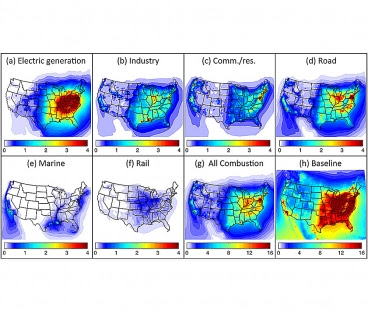A MIT group tracked ground-level emissions from sources such as industrial smokestacks, vehicle tailpipes, marine and rail operations, and commercial and residential heating throughout the United States, and found that such air pollution causes about 200,000 early deaths each year. Emissions from road transportation are the most significant contributor, causing 53,000 premature deaths, followed closely by power generation, with 52,000.
California suffers the worst health impacts from air pollution, with about 21,000 early deaths annually, mostly attributed to road transportation and to commercial and residential emissions from heating and cooking.
The researchers also mapped local emissions in 5,695 U.S. cities, finding the highest emissions-related mortality rate in Baltimore, where 130 out of every 100,000 residents likely die in a given year due to long-term exposure to air pollution.
“In the past five to 10 years, the evidence linking air-pollution exposure to risk of early death has really solidified and gained scientific and political traction,” says Steven Barrett, an assistant professor of aeronautics and astronautics at MIT.
A person who dies from an air pollution-related cause typically dies about a decade earlier than he or she otherwise might have.
The US was producing about 27000 TWh of energy in 2005 (the date of the pollution study).
This study has figure that are higher prior deaths per TWh study indicate.
4100 TWh from electricity generation had 52000 premature deaths.
This is 12.68 deaths per TWh.
Only half of the electricity in the US came from coal which previously had deaths per TWh of 15.
It looks like the figures are indicating about 30-50% more deaths per TWh than from the table below.
Energy Source Death Rate (deaths per TWh) Coal (elect, heat,cook –world avg) 100 (26% of world energy, 50% of electricity) Coal electricity – world avg 60 (26% of world energy, 50% of electricity) Coal (elect,heat,cook)– China 170 Coal electricity- China 90 Coal – USA 15 Oil 36 (36% of world energy) Natural Gas 4 (21% of world energy) Biofuel/Biomass 12 Peat 12 Solar (rooftop) 0.44 (0.2% of world energy for all solar) Wind 0.15 (1.6% of world energy) Hydro 0.10 (europe death rate, 2.2% of world energy) Hydro - world including Banqiao) 1.4 (about 2500 TWh/yr and 171,000 Banqiao dead) Nuclear 0.04 (5.9% of world energy)
Proceedings of the National Academy of Sciences [PNAS] paper’s findings suggest that an arbitrary Chinese policy that greatly increases total suspended particulates (TSPs) air pollution is causing the 500 million residents of Northern China to lose more than 2.5 billion life years of life expectancy.
Abstract
Combustion emissions adversely impact air quality and human health. A multiscale air quality model is applied to assess the health impacts of major emissions sectors in United States. Emissions are classified according to six different sources: electric power generation, industry, commercial and residential sources, road transportation, marine transportation and rail transportation. Epidemiological evidence is used to relate long-term population exposure to sector-induced changes in the concentrations of PM2.5 and ozone to incidences of premature death. Total combustion emissions in the U.S. account for about 200,000 (90% CI: 90,000–362,000) premature deaths per year in the U.S. due to changes in PM2.5 concentrations, and about 10,000 (90% CI: −1000 to 21,000) deaths due to changes in ozone concentrations. The largest contributors for both pollutant-related mortalities are road transportation, causing ∼53,000 (90% CI: 24,000–95,000) PM2.5-related deaths and ∼5000 (90% CI: −900 to 11,000) ozone-related early deaths per year, and power generation, causing ∼52,000 (90% CI: 23,000–94,000) PM2.5-related and ∼2000 (90% CI: −300 to 4000) ozone-related premature mortalities per year. Industrial emissions contribute to ∼41,000 (90% CI: 18,000–74,000) early deaths from PM2.5 and ∼2000 (90% CI: 0–4000) early deaths from ozone. The results are indicative of the extent to which policy measures could be undertaken in order to mitigate the impact of specific emissions from different sectors — in particular black carbon emissions from road transportation and sulfur dioxide emissions from power generation.
If you liked this article, please give it a quick review on ycombinator or StumbleUpon. Thanks

Brian Wang is a Futurist Thought Leader and a popular Science blogger with 1 million readers per month. His blog Nextbigfuture.com is ranked #1 Science News Blog. It covers many disruptive technology and trends including Space, Robotics, Artificial Intelligence, Medicine, Anti-aging Biotechnology, and Nanotechnology.
Known for identifying cutting edge technologies, he is currently a Co-Founder of a startup and fundraiser for high potential early-stage companies. He is the Head of Research for Allocations for deep technology investments and an Angel Investor at Space Angels.
A frequent speaker at corporations, he has been a TEDx speaker, a Singularity University speaker and guest at numerous interviews for radio and podcasts. He is open to public speaking and advising engagements.


